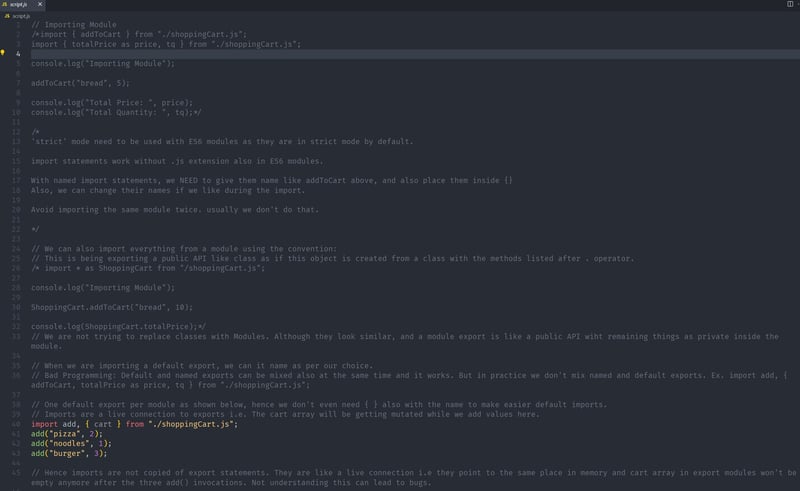JavaScript 模組
發佈於2024-11-08
- 現在我們不再將所有 JS 寫在一個文件中並發送給客戶端。
- 今天,我們將程式碼編寫到模組中,這些模組之間共享資料並且更易於維護。
- 約定是使用駝峰命名法命名模組。
- 我們甚至可以透過 npm 儲存庫將第 3 方模組包含到我們自己的程式碼中,例如 jquery、react、webpack、babel 等。
- 最終的捆綁包是由部署到產品伺服器的小模組檔案建構的,最終發送到客戶端。
- 舊版瀏覽器不支援模組
- 出於效能原因,最好將小js檔案傳送到瀏覽器。
- 模組是 JS 中非常重要的一部分,開發人員已經在其他語言中使用了數十年。
- 模組:可重複使用的一段程式碼,封裝了專案某部分的實作細節。
- 它是一個獨立文件,但不一定是。
- 模組也可以有導入和導出 原生 ES6 模組:ES6 之前沒有模組。必須自己實作或使用外部函式庫。模組儲存在檔案中,每個檔案只有一個模組。
- 我們可以從模組中導出值、函數等。我們導出的任何內容都稱為公共 API,可供其他程式碼使用。
- 此公共 API 透過將公共程式碼匯入模組中來使用,稱為依賴項。
- 簡單的應用程式也可以在沒有模組的情況下編寫,但是對於企業規模的項目,我們需要模組。
高級:
-> 讓軟體的編寫變得非常容易,因為模組是我們組合在一起建立複雜應用程式的小構建塊。
-> 隔離組件:每個功能都可以完全隔離地開發,無需擔心其他開發人員的工作或整個系統的工作方式。
-> 程式碼抽象化:在模組中實作低階程式碼,將這些抽象導入到其他模組中,自然會導致更有組織的程式碼庫。
-> 程式碼可重複使用性:允許我們在多個專案中重複使用程式碼。現代 JS 使用捆綁和轉譯。
## Bundling = is a complex process which involves: a. Eliminate unused Code b. Combine all modules into single file. c. Compress the code. Ex. webpack build tool - requires manual config, hence complex. Ex. parcel - zero build tool as we don't need to write any setup code. ## Transpiling/Polyfiling: Convert modern JS to ES5 or older syntax such that older browser supports the application. Ex. done using tool called Babel Entire process results in the final bundle file for production ready to be deployed on server.
### Scripts are also files but they are different from ES6 modules in the following ways: Script[used earlier]: - All top level variables are always global. This leads to global namespace pollution and name-coliision. - Default mode: Sloppy mode - Top level 'this' points to window object. - Import/Export of values is not allowed. - Linked to html using plain script tag. - Downloaded by default in sync way, unless async or defer attribute is used. ### ES6 Modules: - All top-level variables are scoped to module i.e they are private by default. Such a value can be access by outside varible only when its exported by the module else it will be inaccessible for outside world. - Default mode: Strict mode. Hence with modules no more need to declare strict mode. - Top level 'this' is 'undefined' - Allows import/export of values using ES6 syntax of import/export. - Link to html file using
## Understanding module import process: Parsing -> [Asyn module download, Linking import-export, Execute individual module itself] -> Execution overall index.js - import/export only need to happen at the top level of if-block or any function. Imports are hoisted. Importing values is always the first thing which happens in a module. - Top-level static imports make imports known before execution. - Modules are loaded in async way from the server, importing happens in sync manner. - Parsing refers to reading the code without executing it in which imports are hoisted. Modules are imported even before execution. Hence, it enables bundling & code elimation even before fn exection. [V Impt as large projects have 100s of modules, and 3rd party modules also from which we want the small piece and not the entire module] - Bundlers can then join multiple modules, and then eliminate code. hence, we can easily import/export from code. - After a module arrives, its parsed and then the module exports are linked to imports in index.js i.e live connection is established between import inside index.js and export statement of the module file. They are not copied. Import is just a reference to the exported value. Hence, when the value changes in the exporting module, it also changes in the importing module too. This concept is unique to ES6 modules, other module system don't work like this. - Code in the imported modules is executed.


版本聲明
本文轉載於:https://dev.to/mahf001/javascript-modules-101-2o4m?1如有侵犯,請聯絡[email protected]刪除
最新教學
更多>
-
 FastAPI自定義404頁面創建指南response = await call_next(request) if response.status_code == 404: return RedirectResponse("https://fastapi.tiangolo.com") else: ...程式設計 發佈於2025-07-08
FastAPI自定義404頁面創建指南response = await call_next(request) if response.status_code == 404: return RedirectResponse("https://fastapi.tiangolo.com") else: ...程式設計 發佈於2025-07-08 -
 C++20 Consteval函數中模板參數能否依賴於函數參數?[ consteval函數和模板參數依賴於函數參數在C 17中,模板參數不能依賴一個函數參數,因為編譯器仍然需要對非contexexpr futcoriations contim at contexpr function進行評估。 compile time。 C 20引入恆定函數,必須在編譯時進...程式設計 發佈於2025-07-08
C++20 Consteval函數中模板參數能否依賴於函數參數?[ consteval函數和模板參數依賴於函數參數在C 17中,模板參數不能依賴一個函數參數,因為編譯器仍然需要對非contexexpr futcoriations contim at contexpr function進行評估。 compile time。 C 20引入恆定函數,必須在編譯時進...程式設計 發佈於2025-07-08 -
 如何將MySQL數據庫添加到Visual Studio 2012中的數據源對話框中?在Visual Studio 2012 儘管已安裝了MySQL Connector v.6.5.4,但無法將MySQL數據庫添加到實體框架的“ DataSource對話框”中。為了解決這一問題,至關重要的是要了解MySQL連接器v.6.5.5及以後的6.6.x版本將提供MySQL的官方Visual...程式設計 發佈於2025-07-08
如何將MySQL數據庫添加到Visual Studio 2012中的數據源對話框中?在Visual Studio 2012 儘管已安裝了MySQL Connector v.6.5.4,但無法將MySQL數據庫添加到實體框架的“ DataSource對話框”中。為了解決這一問題,至關重要的是要了解MySQL連接器v.6.5.5及以後的6.6.x版本將提供MySQL的官方Visual...程式設計 發佈於2025-07-08 -
 Java的Map.Entry和SimpleEntry如何簡化鍵值對管理?A Comprehensive Collection for Value Pairs: Introducing Java's Map.Entry and SimpleEntryIn Java, when defining a collection where each element com...程式設計 發佈於2025-07-08
Java的Map.Entry和SimpleEntry如何簡化鍵值對管理?A Comprehensive Collection for Value Pairs: Introducing Java's Map.Entry and SimpleEntryIn Java, when defining a collection where each element com...程式設計 發佈於2025-07-08 -
 如何使用PHP將斑點(圖像)正確插入MySQL?essue VALUES('$this->image_id','file_get_contents($tmp_image)')";This code builds a string in PHP, but the function call fil...程式設計 發佈於2025-07-08
如何使用PHP將斑點(圖像)正確插入MySQL?essue VALUES('$this->image_id','file_get_contents($tmp_image)')";This code builds a string in PHP, but the function call fil...程式設計 發佈於2025-07-08 -
 如何使用Depimal.parse()中的指數表示法中的數字?在嘗試使用Decimal.parse(“ 1.2345e-02”中的指數符號表示法表示的字符串時,您可能會遇到錯誤。這是因為默認解析方法無法識別指數符號。 成功解析這樣的字符串,您需要明確指定它代表浮點數。您可以使用numbersTyles.Float樣式進行此操作,如下所示:[&& && && ...程式設計 發佈於2025-07-08
如何使用Depimal.parse()中的指數表示法中的數字?在嘗試使用Decimal.parse(“ 1.2345e-02”中的指數符號表示法表示的字符串時,您可能會遇到錯誤。這是因為默認解析方法無法識別指數符號。 成功解析這樣的字符串,您需要明確指定它代表浮點數。您可以使用numbersTyles.Float樣式進行此操作,如下所示:[&& && && ...程式設計 發佈於2025-07-08 -
 如何將PANDAS DataFrame列轉換為DateTime格式並按日期過濾?Transform Pandas DataFrame Column to DateTime FormatScenario:Data within a Pandas DataFrame often exists in various formats, including strings.使用時間數據時...程式設計 發佈於2025-07-08
如何將PANDAS DataFrame列轉換為DateTime格式並按日期過濾?Transform Pandas DataFrame Column to DateTime FormatScenario:Data within a Pandas DataFrame often exists in various formats, including strings.使用時間數據時...程式設計 發佈於2025-07-08 -
 將圖片浮動到底部右側並環繞文字的技巧在Web設計中圍繞在Web設計中,有時可以將圖像浮動到頁面右下角,從而使文本圍繞它纏繞。這可以在有效地展示圖像的同時創建一個吸引人的視覺效果。 css位置在右下角,使用css float and clear properties: img { 浮點:對; ...程式設計 發佈於2025-07-08
將圖片浮動到底部右側並環繞文字的技巧在Web設計中圍繞在Web設計中,有時可以將圖像浮動到頁面右下角,從而使文本圍繞它纏繞。這可以在有效地展示圖像的同時創建一個吸引人的視覺效果。 css位置在右下角,使用css float and clear properties: img { 浮點:對; ...程式設計 發佈於2025-07-08 -
 如何使用“ JSON”軟件包解析JSON陣列?parsing JSON與JSON軟件包 QUALDALS:考慮以下go代碼:字符串 } func main(){ datajson:=`[“ 1”,“ 2”,“ 3”]`` arr:= jsontype {} 摘要:= = json.unmarshal([] byte(...程式設計 發佈於2025-07-08
如何使用“ JSON”軟件包解析JSON陣列?parsing JSON與JSON軟件包 QUALDALS:考慮以下go代碼:字符串 } func main(){ datajson:=`[“ 1”,“ 2”,“ 3”]`` arr:= jsontype {} 摘要:= = json.unmarshal([] byte(...程式設計 發佈於2025-07-08 -
 如何高效地在一個事務中插入數據到多個MySQL表?mySQL插入到多個表中,該數據可能會產生意外的結果。雖然似乎有多個查詢可以解決問題,但將從用戶表的自動信息ID與配置文件表的手動用戶ID相關聯提出了挑戰。 使用Transactions和last_insert_id() 插入用戶(用戶名,密碼)值('test','tes...程式設計 發佈於2025-07-08
如何高效地在一個事務中插入數據到多個MySQL表?mySQL插入到多個表中,該數據可能會產生意外的結果。雖然似乎有多個查詢可以解決問題,但將從用戶表的自動信息ID與配置文件表的手動用戶ID相關聯提出了挑戰。 使用Transactions和last_insert_id() 插入用戶(用戶名,密碼)值('test','tes...程式設計 發佈於2025-07-08 -
 在PHP中如何高效檢測空數組?在PHP 中檢查一個空數組可以通過各種方法在PHP中確定一個空數組。如果需要驗證任何數組元素的存在,則PHP的鬆散鍵入允許對數組本身進行直接評估:一種更嚴格的方法涉及使用count()函數: if(count(count($ playerList)=== 0){ //列表為空。 } 對...程式設計 發佈於2025-07-08
在PHP中如何高效檢測空數組?在PHP 中檢查一個空數組可以通過各種方法在PHP中確定一個空數組。如果需要驗證任何數組元素的存在,則PHP的鬆散鍵入允許對數組本身進行直接評估:一種更嚴格的方法涉及使用count()函數: if(count(count($ playerList)=== 0){ //列表為空。 } 對...程式設計 發佈於2025-07-08 -
 在GO中構造SQL查詢時,如何安全地加入文本和值?在go中構造文本sql查詢時,在go sql queries 中,在使用conting and contement和contement consem per時,尤其是在使用integer per當per當per時,per per per當per. [&&&&&&&&&&&&&&&&默元組方...程式設計 發佈於2025-07-08
在GO中構造SQL查詢時,如何安全地加入文本和值?在go中構造文本sql查詢時,在go sql queries 中,在使用conting and contement和contement consem per時,尤其是在使用integer per當per當per時,per per per當per. [&&&&&&&&&&&&&&&&默元組方...程式設計 發佈於2025-07-08 -
 版本5.6.5之前,使用current_timestamp與時間戳列的current_timestamp與時間戳列有什麼限制?在時間戳列上使用current_timestamp或MySQL版本中的current_timestamp或在5.6.5 此限制源於遺留實現的關注,這些限制需要對當前的_timestamp功能進行特定的實現。 創建表`foo`( `Productid` int(10)unsigned not ...程式設計 發佈於2025-07-08
版本5.6.5之前,使用current_timestamp與時間戳列的current_timestamp與時間戳列有什麼限制?在時間戳列上使用current_timestamp或MySQL版本中的current_timestamp或在5.6.5 此限制源於遺留實現的關注,這些限制需要對當前的_timestamp功能進行特定的實現。 創建表`foo`( `Productid` int(10)unsigned not ...程式設計 發佈於2025-07-08 -
 如何簡化PHP中的JSON解析以獲取多維陣列?php 試圖在PHP中解析JSON數據的JSON可能具有挑戰性,尤其是在處理多維數組時。 To simplify the process, it's recommended to parse the JSON as an array rather than an object.To do...程式設計 發佈於2025-07-08
如何簡化PHP中的JSON解析以獲取多維陣列?php 試圖在PHP中解析JSON數據的JSON可能具有挑戰性,尤其是在處理多維數組時。 To simplify the process, it's recommended to parse the JSON as an array rather than an object.To do...程式設計 發佈於2025-07-08
學習中文
- 1 走路用中文怎麼說? 走路中文發音,走路中文學習
- 2 坐飛機用中文怎麼說? 坐飞机中文發音,坐飞机中文學習
- 3 坐火車用中文怎麼說? 坐火车中文發音,坐火车中文學習
- 4 坐車用中文怎麼說? 坐车中文發音,坐车中文學習
- 5 開車用中文怎麼說? 开车中文發音,开车中文學習
- 6 游泳用中文怎麼說? 游泳中文發音,游泳中文學習
- 7 騎自行車用中文怎麼說? 骑自行车中文發音,骑自行车中文學習
- 8 你好用中文怎麼說? 你好中文發音,你好中文學習
- 9 謝謝用中文怎麼說? 谢谢中文發音,谢谢中文學習
- 10 How to say goodbye in Chinese? 再见Chinese pronunciation, 再见Chinese learning

























